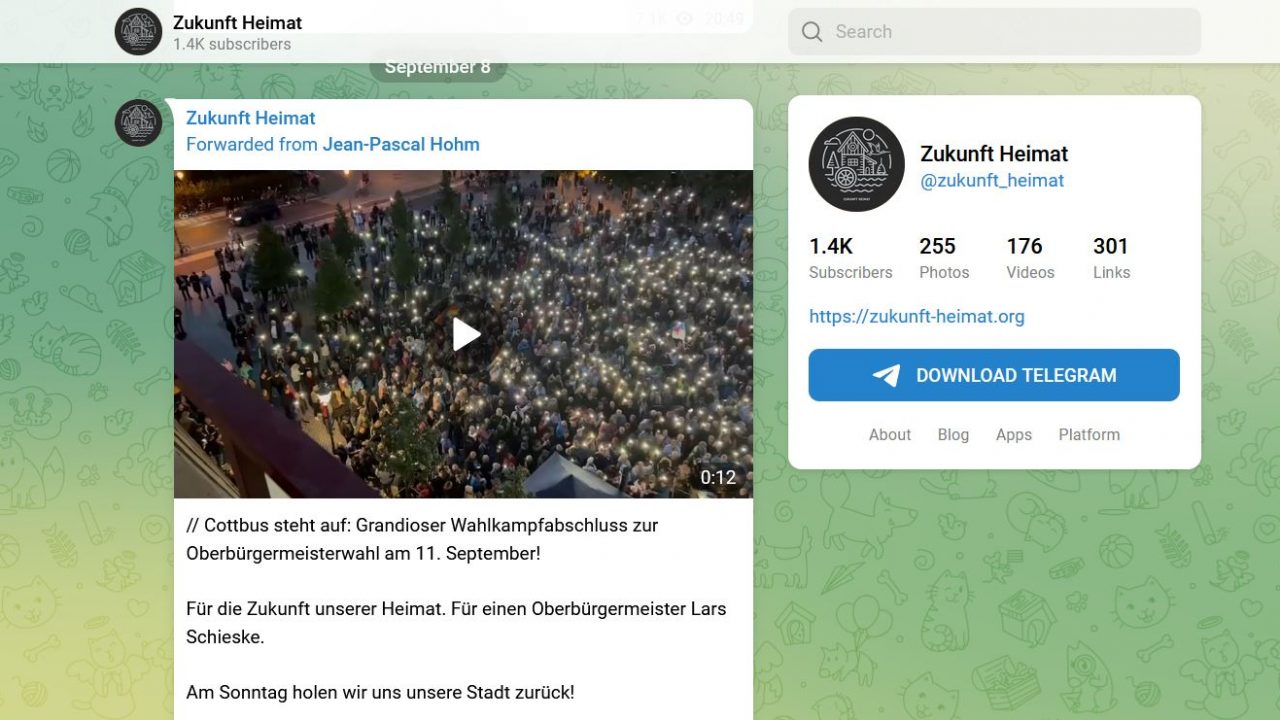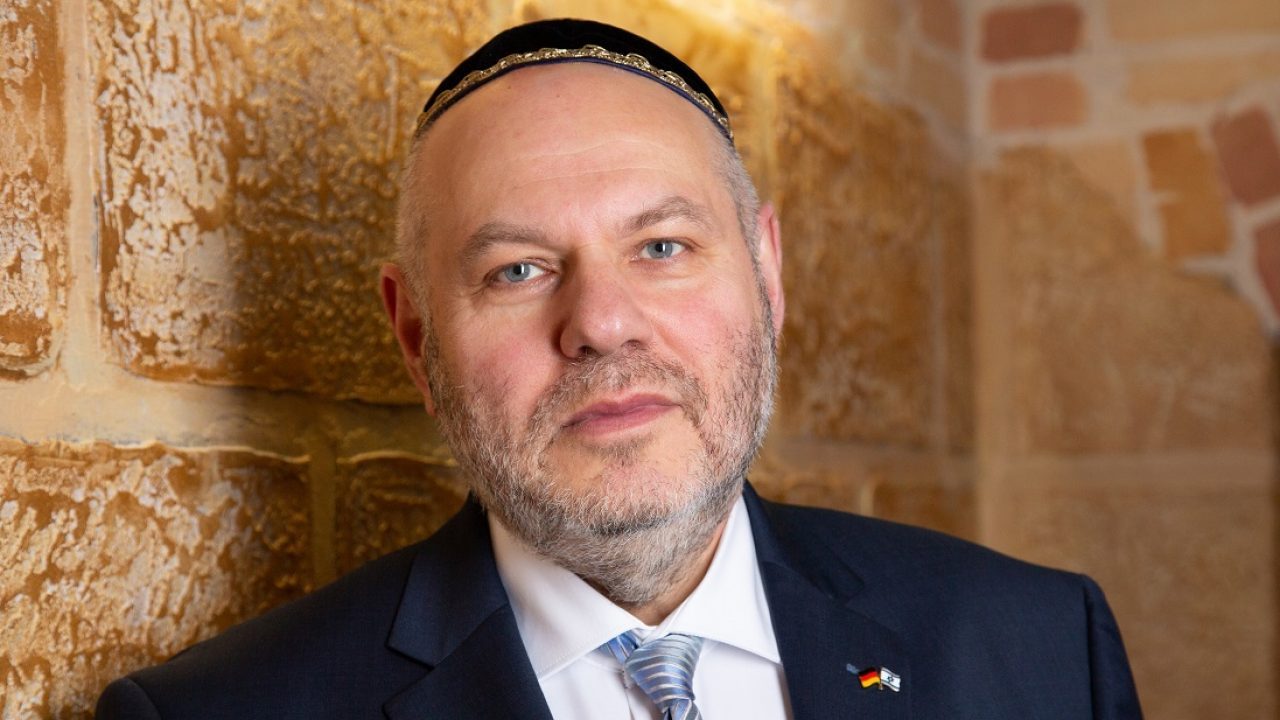
The rabble-rousing campaign is continuing apace: the “Freie Sachsen” movement is joining with other Nazis to call for a “vaccine strike”.
Telegram was founded as a messenger service in Russia in 2013. Its aim: to allow for complete freedom of expression – not least against Putin’s secret service, which made moves to restrict the service. These strong-arming efforts ultimately led the company – established by brothers Nikolai and Pawel Durow – to swap Russia for Dubai, where the firm contends its headquarters is currently based. Since then, Telegram has made it a priority not to work with government authorities and to refrain from moderating, deleting or blocking content as much as possible. Featuring the ability to create groups and channels, the service has long since offered all the features of a social network; in addition to private communication, it allows for ample public and semi-public discourse – which can have dangerous consequences. There are few exceptions to the ‘freedom of opinion’ rule, with only groups revolving around pornography and Islamist
terror being blocked. In addition, in the wake of the 2021 United States Capitol Attack by fanatical, conspiracy-theorist Trump supporters and QAnon followers, a number of major QAnon groups were shut down.
The channel is used by progressive protest movements to stand up to dictatorial regimes, with the conflict in Belarus being a recent notable example. However, it is primarily leveraged by groups – right-wing extremists and Islamic radicals among them – who oppose democracy and who understand ‘freedom of opinion’ to mean the freedom to attack others and incite violence. This goes hand in hand with non-political criminal structures. In Germany, Telegram has around 8 million daily users and is the central platform for the state-wide mobilization of protests against COVID-19 measures.
How Telegram paves the way for radicalisation
It is simple to find or create groups on Telegram itself – or via search engines – and it is likewise easy to share content through these groups: from text messages to videos and voice messages to posts from other groups.
When a user enters one of these content bubbles on Telegram, they are constantly fed new material that validates and reinforces their opinion. Conspiracy ideologies and disinformation are no exception here. This leads to an unchecked, unchallenged flood of messages being directed to the user’s smartphone. As a result, radical right-wingers and “alternative media” sources and influencers that give voice to conspiracy ideologies come across as just as personable and credible as a person’s actual friends, paving the way for the creation of parasocial relationships.
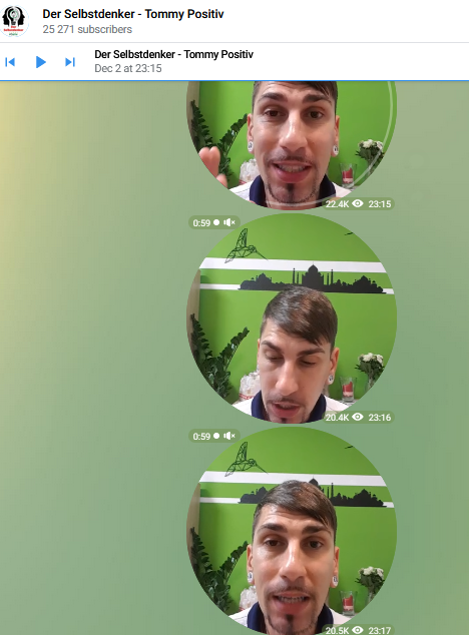
“Tommy Positiv” – this user also refers to himself as an “independent thinker” or “mindset tuner”, and likes to share his “opinion” in seemingly personal video clips.
Telegram also connects people in different ways, like between those protesting against the COVID-19 measures and those who deny the pandemic even exists. Local groups facilitate exchange and allow for the formation of communities, while national and even global groups lend a sense of “significance” to the actions and beliefs of individuals – something which is especially treasured when it comes to conspiracy ideologies. In the channels and groups overrun by “Querdenker” protestors and the like, many of which have been around since March 2020, the tone of influencers and administrators is becoming ever more radicalised – and so is that of ordinary members.
Mobilising users in Saxony through Telegram
In Saxony, anti-democratic demonstrations played down as simple “walks” are organised via Telegram. The platform is used to mobilise participants, document such “walks” in the form of photos and videos – sometimes virtually in real time – and celebrate the success of such gatherings.
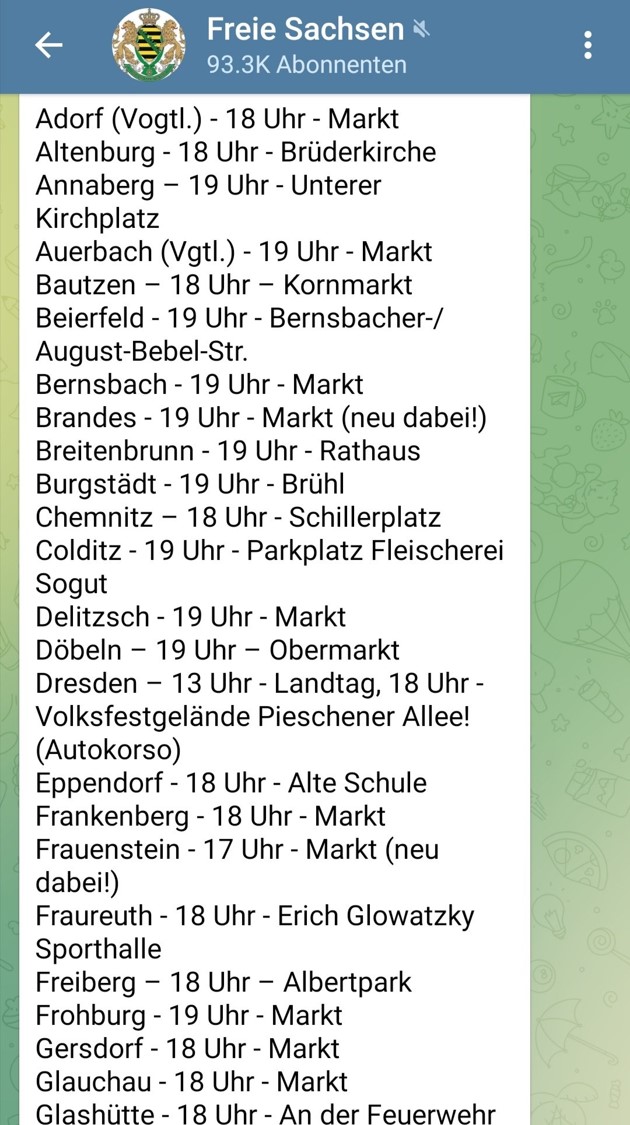
The professionally developed infrastructure also lends itself to organising hate campaigns against, for example, decision-makers in society, whose private addresses are published via the platform. One such campaign led to a far-right mob assembling and waving burning torches in front of the house of Saxony’s health minister Petra Köpping. It isn’t just politicians who are being hounded, either: the addresses of school principals, scientists, physicians and democratically-minded individuals have all been posted.
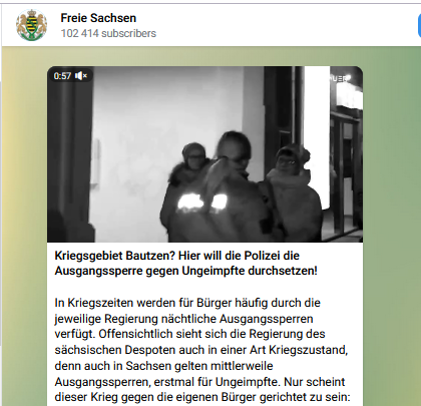
Radical rhetoric: The “Freie Sachsen” movement declares a “state of war” in Saxony.
There are large-scale channels that mobilise and connect people throughout Saxony and nationwide, including:
- Freie Sachsen [Free Saxony]: (102,000+ members)
- Demotermine [Demonstration schedule] (41,000 members)
- Coronainformationskanal [Corona info channel] (49,000 members)
- Influencers like Tommy Positiv (25,000 followers), Michael (Wittwer) from Chemnitz (4,000 followers), Lutz Bachmann, ex-Pegida (8,000 followers), IB activist Alex Malenki (3,800 )
As the monitoring efforts by de:hate Saxony indicate, there are more than 100 channels and 80 groups with a regional focus in Saxony alone. Virtually every major town has its own group. Meanwhile, regional hotspots – such as the Erzgebirge, Vogtland, Eastern Saxony/Lusatia, Dresden and Leipzig – have a higher concentration of Telegram groups/channels. There are virtually no individual users who are in multiple groups, something which may support the thesis that the groups do genuinely form at local level while the channels are used for national networking efforts. An analysis of the admins and creators behind the COVID-19 denier groups reveal personalities which are at home in various – usually antidemocratic – scenes: passionate and organised members of the “Querdenker” movement, coronavirus deniers, people with antidemocratic and anti-egalitarian backgrounds, and individuals with ties to far-right groups (such as the NPD).

Example of a local group: maxims and slogans, accounts alleged to come from personal experience, rabble-rousing against “the government”.
Who is being mobilised?
Saxony is home to different types of groups from varying backgrounds that are united in their “criticism” of the preventive measures against COVID-19 – this is typical of how coronavirus deniers are linked across Germany. These groups include:
- Parents rise up / Children rise up / Students rise up
- Messengers of freedom (Bodo Schiffmann / “Die Basis” [The basis])
- Querdenken [denier movement]
- Esoteric groups
- QAnon conspiracy ideologists
- Groups part of the far-right Identitarian movement
- The far-right group “Freie Sachsen”
- Alternative for Germany (AfD) groups
In other words: far-right channels, channels containing far-right content, “unpolitical” channels listing schedules and agendas, and groups with no far-right content.
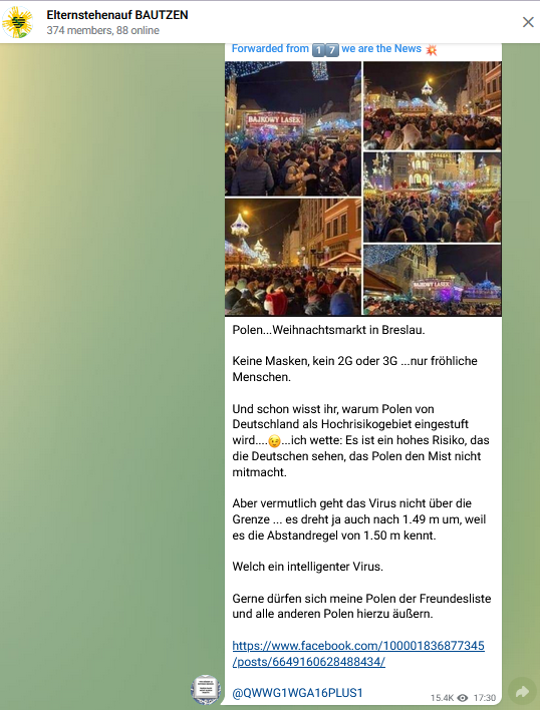
Here, the allegedly “middle-class” group “Parents rise up” shares content from a QAnon conspiracy channel, as evidenced by the handle (at the bottom) “QWWG1WGA”, a code used by QAnon fans (Where we go one, we go all).
Are any developments afoot? Are the groups increasing in size?
Yes – across Germany and in Saxony in particular, as evidenced by investigations conducted by the Institute for Democracy and Civil Society in Jena. The two graphs below show this clearly:
“Demotermine” [demonstration schedule] channel (national):
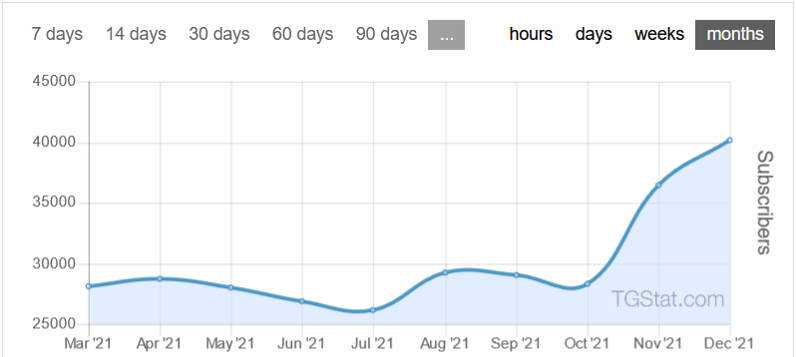
“Freie Sachsen” channel:
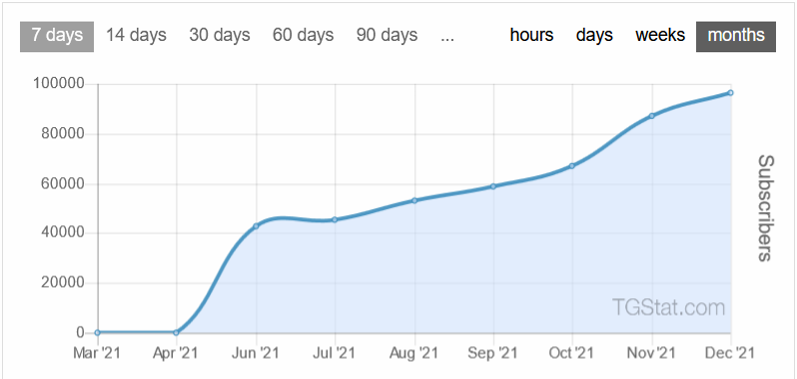
The growth in the size of these Telegram groups is leading to more than protests alone. Events on the street have also been observed to fuel the growth of such groups. In other words, the system has become mutually reinforcing.
What do right-wing extremists have to do with the mobilisation of people online?
Channels and groups that support conspiracy ideologies and radical right-wing narratives play a decisive role in the mobilisation process. Among the national actors (those with 500+ followers) in Saxony and Thuringia seeking to mobilise people, it is far-right groups that are setting the tone: as already mentioned above, Saxony is home to the “Freie Sachsen” movement, a tiny party founded by right-wing extremists which is also responsible for running the eponymous Telegram channel, while Thuringia counts “Erfurt zeigt Gesicht” [Erfurt Shows Character] and the “Thüringer Widerstand” [Thuringian Resistance] among its agitators.

Here, the “Thuringian Resistance” disseminates a video statement featuring a woman in uniform. The aim: to encourage Germany’s police officers to betray the nation.
The large-scale nationwide mobilisation channels and groups (such as “Demotermine” and “Deutschland Info Chat”) have not come into existence in the wake of the coronavirus pandemic – they have been around for years already. Scrolling back through the channel reveals a history of efforts to mobilise people.

Their efforts have seen them mobilise people as part of:
- “Yellow vests protests” and Islamophobic protests
- Far-right demonstrations “against the Global Compact for Migration”
- “Third Way” events and events for Holocaust denier Ursula Haverbeck
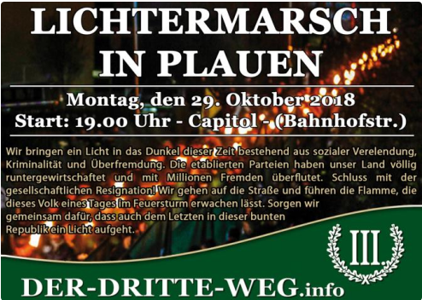
These channels have a long-term, radical right-wing, antidemocratic focus and agenda – and are the ones that are continuing to push for mobilisation and set a decidedly radicalised tone when it comes to calling on COVID-19 deniers to take to the streets in protest.
“Freie Sachsen”: a small right-wing party serving as a digital hub
The main channel run by the far-right group “Freie Sachsen” (click here for more about the party) has more than 102,000 members, with its ranks swelling virtually on the hour.

Cribbed from Pegida and Alternative for Germany: “Freie Sachsen” employs an eye-catching visual style with a strong recognition factor.
There is also a network consisting of regional subgroups on Telegram, including:
- Freie Erzgebirger [Free Erzgebirge Citizens]
- Freie Mittelsachsen [Free Central Saxony]
- Freie Ostsachsen [Free East Saxony]
- Freie Sachsen Dresden [Free Saxony: Dresden Chapter]
- Freie Sachsen Vogtland [Free Saxony: Vogtland Chapter]
- Freie Sachsen Leipzig [Free Saxony: Leipzig Chapter]
- Freie Sachsen Zwickau [Free Saxony: Zwickau Chapter]
- Freie Sachsen Sächsische Schweiz / Osterzgebirge [Free Saxony: Saxon Switzerland / East Erzgebirge]
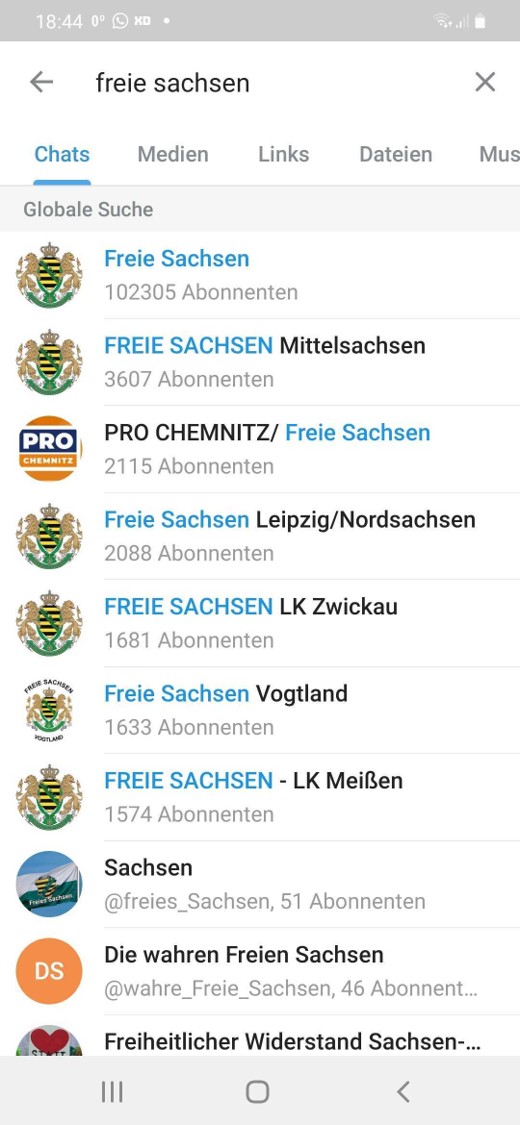
Some regional groups now boast a substantial number of members.
The interaction between the main channel and the wider network is speeding up the process of radicalisation and consolidating the follower base. The main channel functions as a mouthpiece for the individual regional groups, taking the content posted in the smaller groups and sharing it on the “Freie Sachsen” main channel. In other words, the “Freie Sachsen” channel is a networking platform, where protest dates are collected and disseminated and the protests themselves are well documented. This helps the members to believe they are of the majority opinion, as the channel exclusively shows photos and videos of protests at different locations throughout the state. This conviction is bolstered by sensationalist articles and malicious commentary, while images, slogans and memes are used to create an emotional connection.
How Telegram is used to radicalise coronavirus protests in Saxony
- Telegram groups are a low-threshold entry point into the coronavirus protest scene.
- Groups and channels can be created quickly and easily. It is easier to share media content (e.g. videos) over Telegram than other major platforms.
- This makes it simple for individual actors to receive attention quickly.
- Groups and channels in support of conspiracy ideologies are mixed in with family chats, making it convenient for people to share access to them.
- The different types of groups constitute a low-threshold entry point for different spectra.
- As all events are shared permanently, regional events are wont to receive sudden national attention. This meets the need for self-efficacy and exaggerates their degree of importance, making members believe that their respective “walks” are in service of a higher purpose.

After Minister President of Saxony Michael Kretschmer requested police reinforcement from other federal states at the weekend, “Freie Sachsen” referred to them as “mercenaries” seeking to detain “citizens of Saxony”.
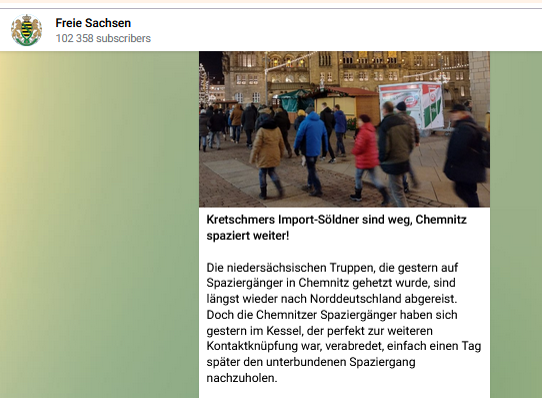
These “imported mercenaries” (actually police officers seeking to enforce the coronavirus preventive measures), as “Freie Sachsen” call them, were “set loose on citizens out for a walk”. The rhetoric could hardly be more hostile.
- The tone of the groups is consistently hostile toward decision makers and parliamentary democracy, while those groups that openly embrace conspiracy ideologies use antisemitic language.
- Individuals are presented as the enemy and doxxed when the opportunity arises.
- All means – violence, murder, execution – are seen as legitimate responses.
- War rhetoric (civil or otherwise) and calls for a military coup are the norm.
- In Germany’s eastern states, individuals often call for a new revolution and propagate a GDR 2.0 narrative.
- The groups are able to justify a perceived need to act and convey the belief that they are on the side of good / knowledge / exclusivity.
What does the future hold?
For one thing, the groups under the “Free xxx” banner are continuing to expand throughout Germany. There are already various groups of different sizes that are active across Telegram, with protest groups on the streets of Brandenburg and Thüringen adopting the moniker.
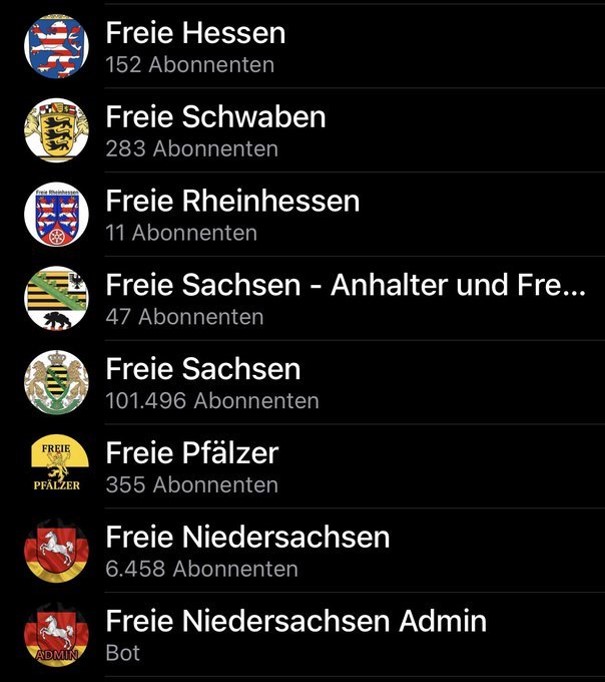
For another, calls are being made in the major public channels for members to migrate to private groups, and attempts have been made to isolate existing groups from the greater whole and organise offline networks. The goal: to create a more exclusive core of followers who are willing to take action and incite violence.
Both are unsettling developments.
What can be done against it?
Up to now, Telegram has not cooperated with the German authorities. The Network Enforcement Act (NetzDG) against hate and incitement online does not yet cover messenger services, but is set to be expanded to cover them starting in February 2022. This will provide a basis for regulating services like Telegram. That said, Telegram is already behaving in an illegal manner. Its website, for example, does not contain a legal notice or list a legal contact person in Germany. This has led to notices of fines being sent to the company. It is not known whether the fines have been paid.
The outcome of failing to pay the fines is similarly unclear. Would the network be blocked? Would it have to cease operations in Germany? Or will the state push for a Europe-wide solution, as is the case with the Digital Services Act (DSA) currently being discussed in the European Parliament. Thus far, the draft act contains no provisions to regulate
Telegram. An attempt to do so would be prudent, but the fact remains that this is a long-term solution that will take years to enforce – years during which radical communication can be used by far-right groups to undermine the very foundations of democracy.
Counter-arguments by other Internet users – or attempts to refute claims and educate people – is another strategy that has proven unsuccessful on Telegram. The channels and groups all have admins who can quickly expel anyone who speaks out against the prevailing opinion and creates unrest. This is one reason why the process of radicalisation is so successful on Telegram: there is simply no way to challenge the belief in conspiracy ideologies.
Corporate institutions that take a stand can have a positive impact: for example, after the United States Capitol attack, the app stores run by Google and Apple introduced a new version of Telegram that no longer showed all groups and channels from the outset. This is a step in the right direction and a sign that things will not continue as they have done up to now. The hope is that this momentum can be built upon. Do channels on Telegram genuinely need to be listed on (high-reach) search engines? Is it essential to be able to share Telegram links on other platforms? Such measures could have an impact on the reach and low threshold of Telegram.
In addition, the police need to ramp up their efforts to prosecute people on the platform. Many individuals use their real names on Telegram, and state their employer and place of residence – they feel safe in the knowledge that they are in the right, even as they utter death threats to others.
Finally, every user should take the time to think about whether they want to keep using Telegram – a network that comprehensively refuses to take action against hate-fuelled content that is both inhumane and a threat to democracy.
This article features findings by de:hate Saxony and the Institute for Democracy and Civil society.
This article is also available in German:

